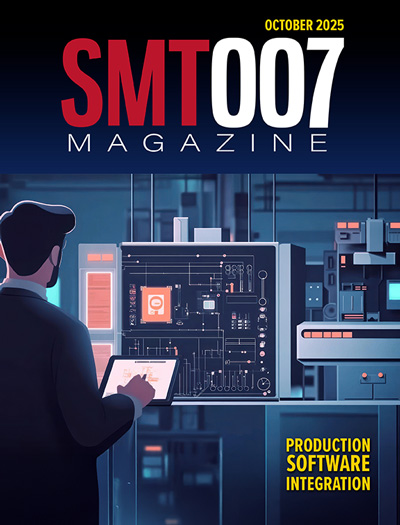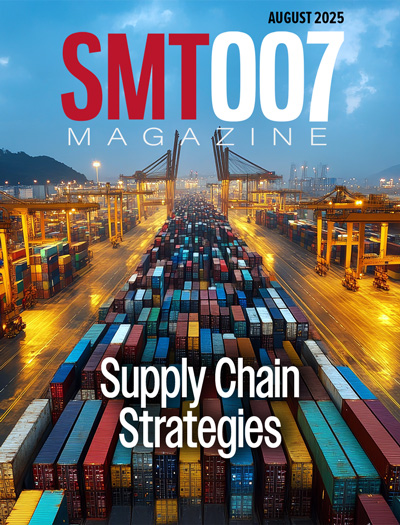-

- News
- Books
Featured Books
- smt007 Magazine
Latest Issues
Current Issue
Production Software Integration
EMS companies need advanced software systems to thrive and compete. But these systems require significant effort to integrate and deploy. What is the reality, and how can we make it easier for everyone?

Spotlight on India
We invite you on a virtual tour of India’s thriving ecosystem, guided by the Global Electronics Association’s India office staff, who share their insights into the region’s growth and opportunities.

Supply Chain Strategies
A successful brand is built on strong customer relationships—anchored by a well-orchestrated supply chain at its core. This month, we look at how managing your supply chain directly influences customer perception.
- Articles
- Columns
- Links
- Media kit
||| MENU - smt007 Magazine
How Do I Get Smart With IPC CFX? (Part 2)
July 31, 2019 | Michael Ford, Aegis Software Corp.Estimated reading time: 10 minutes
In Part 1, Michael Ford described automation in the SMT assembly industry and where CFX fits in. In Part 2, Ford looks at the CFX adoption, the values and challenges of digitalization with CFX, and the scope of CFX utilization.
CFX Adoption
Historically, as well as the lack of defined data content, legacy communication standards within assembly manufacturing failed to become widely adopted due to related costs and difficulties to implement. In the case of CFX, a free, open-source software development kit (SDK) is available to anyone who would like to fast-track support of CFX into their machines or IT solutions. The CFX SDK is available through the GitHub source-code sharing site and comes with full documentation covering messages and data structures. This can be freely incorporated into commercial applications, including machines, bespoke processes—such as functional test equipment—as well as various manufacturing solutions.
Though it is expected that there will be a wide range of adoption of CFX by mainstream equipment vendors, there will be cases where older machines will remain unsupported without native CFX support. In these cases, CFX capability can be provided through the use of a simple, inexpensive add-on box, which could contain a Raspberry Pi computer with any required inputs and outputs to gather and deliver data between the machine and the CFX environment, for example. Customization of the software within the add-on box is likely depending on the machine to which it is being applied.
Values and Challenges of Digitalization With CFX
The challenges of factory digitalization, in line with expectations of smart factory or Industry 4.0, are almost completely removed with the adoption of CFX. In terms of the manufacturing business, requirements for data needed for critical decision-making support needed for fully flexible factory operations are fully met through the specific information definition and timing of CFX messages. Innovation towards smart factory solutions can finally begin on a practical basis.
CFX is sustainable since it affords the same opportunity for machine vendors to create their own added-value solutions and values through the use of CFX data derived from other machines and processes. The ability for machine vendors to generate product enhancement and create additional revenue streams adds to their benefit from CFX of the elimination of costs to create and support bespoke interfaces for customers. IT teams and solution providers also benefit significantly, as the cost of data acquisition becomes a mere fraction of what it once was. In addition, the data has better quality, detail, and consistency, and is capable of supporting further smart solutions and Industry 4.0 innovation.
Scope of CFX Utilization
There are as many potential values from the use of CFX data as there are ideas for smart functions in assembly factories. The scope of CFX has been defined to include support for all known and existing software functions as well as those expected in the future. There are three layers of information exchange within the typical assembly factory. CFX is designed to support all three, including the connection of each layer.
Figure 4: Examples of CFX message transfer.
Each of the three layers shown in Figure 4 provides information through CFX as well as utilizing data from other layers and processes. CFX creates the “big data” environment in assembly manufacturing. The following four examples are each based on a different flow of CFX messages.
1. CFX Machine-to-Machine, Closed-loop Application
The principle of a “closed-loop” is that the analysis of the output of a process is used to modify the input and operational parameters used throughout the process. There are several ways of applying closed-loops on an SMT manufacturing line with many examples having been developed. Unfortunately, these legacy examples rely on bespoke machine connections that have been set up with extensive work and testing and only work with specific combinations of machines with specific software versions. With CFX, as long as each machine supports CFX, the connection of advanced closed-loops is as simple as “plug and play.”
The closed-loop application may be provided by any one of the machine vendors in the line, a third-party software, or even a combination. Figure 5 shows an example of a more complex closed-loop line.
Figure 5: CFX machine-to-machine, closed-loop example application.
The sequence of steps performed is as follows:
- Each uniquely identified PCB flows in from the left
- The screen-printing operation is performed
- The paste inspection operation is performed
- Data from the paste inspection (1) is analyzed to find deviations between the specified printing position as determined by the engineering data and the actual measured position
- Following analysis, a correction parameter (2) is sent to the screen printer to compensate for the printing deviation such that the next PCBs should not have any deviation
- In addition, a compensation factor parameter (2) is sent to the SMT placement machine such that placements on the specific production unit analyzed will not be affected by the printing deviation that already occurred; this compensation factor is also fed to the optical inspection machine so that the compensation applied by SMT is not reported as an error
- The optical inspection machine, bearing in mind the placement compensation, will also measure any deviation in the placements (3) and feed the data back to the SMT placement machine
- The SMT placement machine can analyze the data from the automated inspection machine to determine any root causes—for example, whether deviations are simple offsets, skews, related to a nozzle, head or feeder, etc.—such that corrective action can be suggested back to the SMT placement machine operator
The effect of such closed-loop operations, looking at historical examples, have resulted in an order of magnitude improvement in first-pass yield together with associated reduction of losses in productivity and quality.
Page 1 of 2
Testimonial
"In a year when every marketing dollar mattered, I chose to keep I-Connect007 in our 2025 plan. Their commitment to high-quality, insightful content aligns with Koh Young’s values and helps readers navigate a changing industry. "
Brent Fischthal - Koh YoungSuggested Items
EMS Solutions Expands Workforce to Meet Rising Demand for U.S.-Based Electronics Manufacturing
10/17/2025 | EMS SolutionsEMS Solutions, a premier regional provider of Electronics Manufacturing Services (EMS), has announced several new hires across key departments as the company continues to grow its capabilities and meet increasing customer demand.
Jabil Announces Board Transitions
10/17/2025 | JabilJabil Inc. announced that Executive Chairman of the Board of Directors Mark T. Mondello and Directors Kathleen A. Walters and Jamie Siminoff will not seek re-election at Jabil’s Annual Meeting of Stockholders in January 2026.
StenTech Strengthens Precision Parts Platform with AME Acquisition
10/17/2025 | StenTechStenTech, North America’s leading provider of SMT printing solutions and precision manufacturing, has announced the acquisition of Advanced Metal Etching, Inc. (AME), a recognized specialist in chemically etched and laser cut precision parts.
MKS’ Atotech, ESI to Participate in TPCA Show & IMPACT Conference 2025
10/17/2025 | MKS’ AtotechMKS Inc., a global provider of enabling technologies that transform our world, announced that its strategic brands Atotech (process chemicals, equipment, software, and services) and ESI (laser systems) will showcase their latest range of leading manufacturing solutions for printed circuit board (PCB) and package substrate manufacturing at the upcoming 26th TPCA Show 2025 to be held at the Taipei Nangang Exhibition Center from 22-24 October 2025.
Primax, Vieureka Partner to Drive Next-Generation EDGE AI
10/17/2025 | PRNewswirePrimax Electronics Ltd., a leading global ODM with AI sensor fusion technologies, and Vieureka Inc., a Japanese edge AI innovator, announced a strategic partnership to develop a next-generation edge AI camera.


